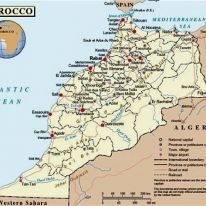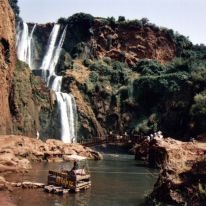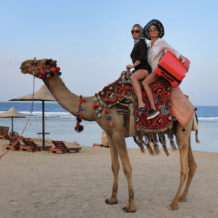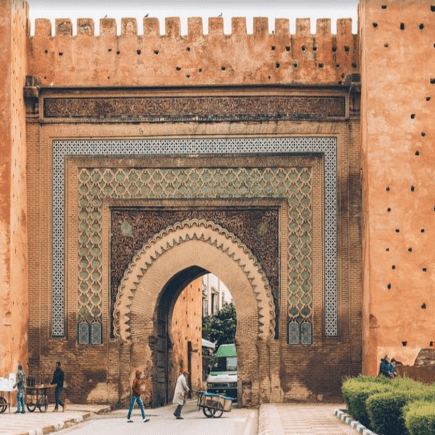
Is Moulay Idriss & Volubilis worth a Day Trip from Fes?
Travelers to Fes often ask if Moulay Idriss is worth a day trip. For history buffs, wine connoisseurs, and nature enthusiasts, the answer is always yes. The scenic town is located 63 kilometers from Fes, surrounded by olive and almond trees, dispersed over two hills at the foot of Mount Zerhoun. Moulay Idriss is considered one of Morocco’s holiest sites. In 789, Moulay Idris Al Akbar, the great-grandson of the Prophet Muhammad, settled in Moulay to seek refuge from the Abbasid and Alid dynasties. Moulay Idriss is credited with bringing Islam to the western Maghreb and the settlement is named after him. Today the holy site is an acceptable substitute for Moroccan Muslims who cannot complete the Haj journey to Mecca. Legend has it that five trips to Moulay Idriss during one lifetime can equal a trip Mecca.
Until 2005, travelers to the North African city were not permitted to stay overnight. Moulay Idriss became a mystical place surrounded by myths likely spread to keep it a secret. After Edith Wharton visited Moulay Idriss in 1919 to research for her novel In Morocco, she explained the law stipulated she must depart by 3pm. Wharton was one of the first foreigners to discover and write about the hilltop town that still feels suspended in time. Even though curfew restrictions have now been lifted for foreign visitors, life still moves slowly in Moulay Idriss. Moulay Idriss’ close neighbor Volubilis, located just 5 kilometers away, has a similar rhythm to the sacred site.
Moulay Idriss & Volubilis offer a wide array of things to do for visitors as part of a Morocco Tour or Day trip from UNESCO Fes.
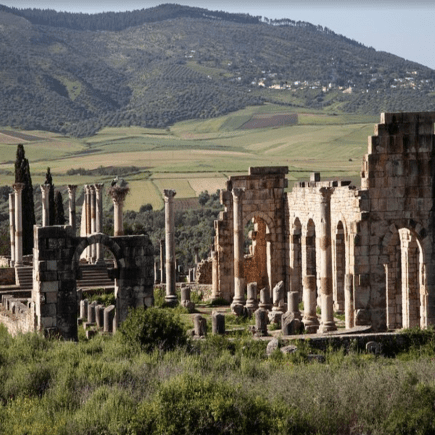
What is the History of Moulay Idriss?
Volubilis is often linked to Moulay Idriss and they are often both visited on an excursion from Fes. The materials to build Moulay Idriss were likely sourced from Volubilis. When the Romans settled Volubilis around 25 BC and proclaimed it as the Roman capital of Mauritania, the Roman Emperor Augustus appointed the Berber Prince Juba II as ruler. He also proposed that Juba II marry the daughter of Marc Anthony and Cleopatra. As a result, Volubilis’ Roman and Moroccan connections are tightly interwoven. These close relations resulted in olive and grain production and exports to Rome. Today, the region of Volubilis is sought after for its wine and olive oil, with local producers receiving awards for their fine fine production. The land is also revered for its natural beauty and its complete ancient Roman site. In spite of an 18th earthquake that devastated Volubilis, the 40-hectare large Roman city has well-preserved temples, mosaic floors, columns, and a paved road. In the 20th century during the French rule, Volubilis was excavated. Some travelers have expressed that after Pompei, Volubilis has one of the largest Roman ruins. For almost 700 years Volubilis became a melting pot of Latin speaking Christians, Africans, Syrians, Spaniards, Jews, and Muslims. It was significant to the point that until Fes became the region’s administrative capital, Volubilis was the chosen capital of Idris I. In 1997, UNESCO inscribed Volubilis as a registered site.
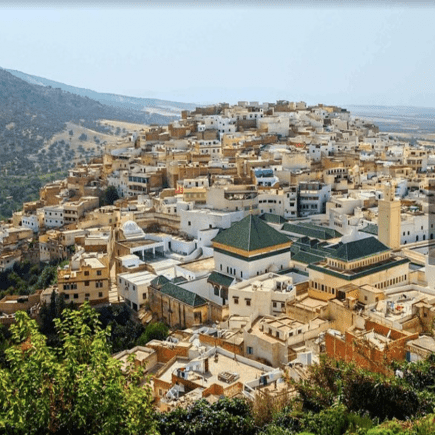
What are the Top 10 Things to do in Moulay Idriss & Volubilis?
1. Tomb of Moulay Idriss
Visit the main sight of the hilltop city is the tomb of Moulay Idriss. There are several hiking trails that lead to the tomb and it is an ideal location for photography enthusiasts. Among the things to capture inside the Saiss Valley beneath the town and the olive groves that dress up the countryside. Unfortunately, only Muslims can enter the site and the main entrance is blocked by a low wooden bar.
2. Idriss Medersa
This historical 17th-century Koranic school was built using Roman materials. Setting the medersa apart is its cylindrical minaret used to call Muslims to prayer. Added on in 1939, the unique tower is distinguished by a pattern of white and green geometric shapes. It is decorated with an Arabic inscription chosen from the Koran. Although none of Moulay Idriss’ shrines are open to non-muslims, this architecturally interesting building continues to attract visitors.
3. Explore the Ancient Roman Ruins at Volubilis
From sunrise to sunrise the historical home of the once established Roman society can be explored. Among the highlights include remains of bronze and marble statues discovered from prior excavations, a forum with sky-high columns, the remains of a basilica, floor mosaics, the triumphal Arch of Caracalla, and the first private hammam. There is a 20 MAD ($2 USD) fee to enter however it recommended exploring Volubilis alongside a knowledgable guide.
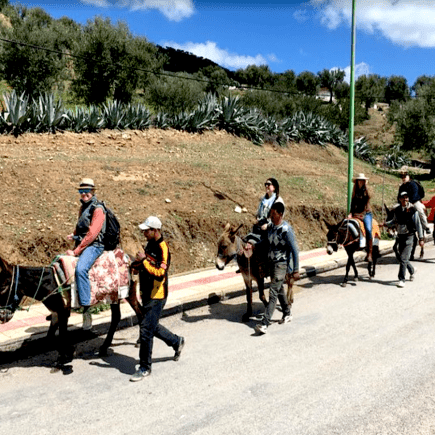
4. Donkey ride from Moulay Idriss to Volubilis
The donkey is considered one of Morocco’s most important animals. The animal is often seen carrying piles of large objects. These include TVs, furniture, sacks of spices, and other construction materials on its back. Particularly in Fes, Morocco’s spiritual capital, located less than an hour from Moulay Idriss, the donkey is the main source of transportation inside the urban free UNESCO certified medina. Over 100,000 people live in Fes and rely on the donkey. Given the animal’s strength and reliability, the town has arranged for travelers to the holy city to take a donkey ride. The experience starts in the main square, goes through the town park and mountain road, through the Moulay Idriss olive groves and into the ancient Roman city Volubilis. Highlights of the ride include scenic views of the Zerhoune mountain range and the Volubilis valley.
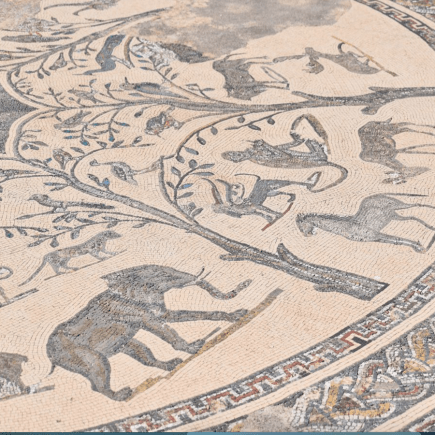
5. House of Orpheus
This is one of the most coveted destinations in the Moulay Idriss Volubilis region. The Roman ruins are famous for their well preserved mosaic floors that were once part of townhouses owned by affluent families. The mosaic tilework tells stories of an ancient past through its depiction of the scenery of daily life. These include a tragic story about a hunter who turned into a stag by the Goddess Diana; he was mistakenly killed by his own dogs. There also many other scenes that depict Greek and Roman gods drinking wine and a massive floor mosaic showing Orpheus playing the harp for his animals. Other illustrations of dolphins in waves and scenes of nymphs can be found. While the House of Orpheus dates to the 1st century, it is said the mosaics could have been taken over 50 years to make.
6 Step back in time, Moulay Idriss offers a Full Immersion in Local Traditions
A visit to Moulay Idriss offers travelers the opportunity to travel back in time and observe traditional Moroccan life. Favorite activities include taking a market tour of the artisanal shops, learning how to bread in the community ovens, and signing up for a cooking class with a local Moroccan mother. Not far from the main town square is also one of Morocco’s oldest and most traditional hammams. Those who want to discover Morocco’s ancient beauty secrets can take an hour and experience the Moroccan bathhouse.
7. Bathe in Roman Hot Springs in the Foothills of Mount Zerhoune
A unique experience is to take a dip in the historical Roman hot springs. Located along the foothills of Mount Zerhoune, the hot stone water is mixed with the medicinal cumin herb. The water is said to yield therapeutic and beautifying results. Even for those that don’t want to bathe, the 10-minute hike into the scenic hills is worth the climb. From the bath location, you can look over the vast plains and get a sense of the Volubilis region.
8. Olive Tasting
Olive oil production has a long history in the Moulay Idriss region. Just 5 kilometers away, Volubilis was a final stop on the Roman imperial road that traveled from France to Spain, and northern Morocco to Fes. The area was originally chosen by the Romans for its fertile grounds. They wanted to cultivate grains and olive oil and export them home. As a result, the Romans are credited for introducing the sundial, olive press, and cooking utensils to Morocco. Although these inventions helped the local economy, the Berbers and the Romans did not get along and after 300 years, they left the northern kingdom. The melange of these cultures yielded a history in which Christianity was practiced and Latin was used to communicate between the Jews, Syrians, and Greeks living in Volubilis.
9. Dining at Scorpion House
Perched on top of two hills, Dar Akran, or the Scorpion House is one of the traveler’s favorite lookout spots. Its minimalist terrace sits on a cliff and is an idyllic spot to enjoy the incredible mountain view. The Scorpi0n House is an excellent place from which to dine and watch the sunset color the historical town. The property is a coveted spot for travelers and is available by advance reservation only. Owned by Mike Richardson, a British expatriate well known in Morocco for his Cafe Clock establishments. Menu favorites at Scorpion Hosue include merguez sausage and date stuffed rabbit and the Berber Mechouia-style lamb. It is also a good place to try the famous Moulay Idriss and Volubilis olives. The Scorpion House is available for group dining experiences and as a home rental for those looking to extend their stay in Moulay.

10. Wine Tasting at Domaine de la Zouina
Aa result of its long Roman history, the 3rd century B.C. Berber town has one of the best wine vineyards in Morocco. Situated at the foot of the Middle Atlas, the Domaine de La Zouina invites travelers to discover its vineyards, facilities, and taste its three Domaine wines. Wine tastings are accompanied by the region’s award-winning olive oil, dried fruits, nuts, and local goat cheese.

